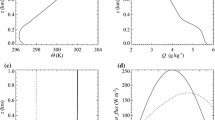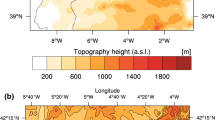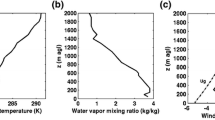Abstract
Numerical simulations of the evolution of the planetary boundary layer (PBL) and nocturnal low-level jets (LLJ) have been carried out using MM5 (version 3.3) with four-dimensional data assimilation (FDDA) for a high pollution episode in the northeastern United States during July 15–20, 1999. In this paper, we assess the impact of different parameterizations on the PBL evolution with two schemes: the Blackadar PBL, a hybrid local (stable regime) and non-local (convective regime) mixing scheme; and the Gayno–Seaman PBL, a turbulent kinetic energy (TKE)-based eddy diffusion scheme. No FDDA was applied within the PBL to evaluate the ability of the two schemes to reproduce the PBL structure and its temporal variation. The restriction of the application of FDDA to the atmosphere above the PBL or the lowest 8 model levels, whichever is higher, has significantly improved the predicted strength and timing of the LLJ during the night. A systematic analysis of the PBL evolution has been performed for the primary meteorological fields (temperature, specific humidity, horizontal winds) and for the derived parameters such as the PBL height, virtual potential temperature, relative humidity, and cloud cover fraction. There are substantial differences between the PBL structures and evolutions simulated by these two different schemes. The model results were compared with independent observations (that were not used in FDDA) measured by aircraft, RASS and wind profiler, lidar, and tethered balloon platforms during the summer of 1999 as part of the NorthEast Oxidant and Particle Study (NE-OPS). The observations tend to support the non-local mixing mechanism better than the layer-to-layer eddy diffusion in the convective PBL.
Similar content being viewed by others
References
Cohn, S.A. and Angevine, W.M.: 2000, Boundary layer height and entrainment zone thickness measured by lidars and wind-profiling radars, J. Appl. Meteorol. 39, 1233–1247.
Shafran, P.C., Seaman, N.L. and Gayno, G.A.: 2000, Evaluation of numerical predictions of boundary-layer structure during the Lake Michigan Ozone Study (LMOS), J. Appl. Meteorol. 39, 412–426.
Alapaty, K., Pleim, J.E., Raman, S., Niyogi, D.S. and Byun, D.W.: 1997, Simulation of atmospheric boundary layer processes using local-and nonlocal-closure schemes. J. Appl. Meteorol. 36, 214–233.
Ku, J.-Y., Mao, H., Zhang, K., Civerolo, K., Rao, S.T., Philbrick, C.R., Doddridge, B. and Clark, R.: 2001, Numerical investigation of the effects of boundary-layer evolution on the predictions of ozone and the efficacy of emission control options in the northeastern United States, Environ. Fluid. Mech. 1, 209–233.
Dudhia, J.: 1993, A nonhydrostatic version of the Penn State-NCAR Mesoscale Model: validation tests and simulation of an Atlantic cyclone and cold front, Mon. Wea. Rev. 121, 1493–1513.
Grell, G.A., Dudhia, J. and Stauffer, D.R.: 1994, A Description of the Fifth-Generation Penn State/NCAR Mesoscale Model (MM5), National Center for Atmospheric Research, Boulder, CO.
Byun, D.W. and Ching, J.K.S.: 1999, Science Algorithms of the EPA MODELS-3 Community Multiscale Air Quality Model (CMAQ) Modeling System, U.S. Environmental Protection Agency, Washington, DC.
Stauffer, D.R. and Seaman, N.L.: 1990, Use of four-dimensional data assimilation in a limitedarea mesoscale model. Part I: experiments with synoptic scale data, Mon. Wea. Rev. 118, 1250–1277.
Stauffer, D.R., Seaman, N.L. and Binkowski, F.S.: 1991, Use of four-dimensional data assimilation in a limited-area mesoscale model. Part II: effects of data assimilation within the planetary boundary layer, Mon. Wea. Rev. 119, 734–754.
Seaman, N.L.: 2000, Meteorological modeling for air-quality assessments, Atmos. Environ. 34, 2231–2259.
Biswas, J. and Rao, S.T.: 2001, Uncertainties in episodic ozone modeling stemming from uncertainties in the meteorological fields, J. Appl. Meteorol. 40, 117–136.
Sistla, G., Hao, W., Ku, J.Y., Kallos, G., Lagouvardos, K., Kotrini, V., Zhang, K., Mao, H. and Rao, S.T.: 2001, An operational evaluation of two regional-scale ozone air quality modeling systems over the eastern United States, Bull. Amer. Meteorol. Soc. 82, 945–964.
Blackadar, A.K.: 1979, High resolution models of the planetary boundary layer. In: J. Pfafflin and E. Zeigler (eds.), Advances in Environmental Science and Engineering, pp. 50–85, Gordon and Breach, New York.
Gayno, G.A., Seaman, N.L., Lario, A.M. and Stauffer, D.R.: Forecasting visibility using a 1.5-closure boundary layer scheme in a 12-km non-hydrostatic model. In: Tenth Conference on Numerical Weather Prediction, pp. 18–20, American Meteorological Society, Boston, MA.
Troen, I. and Mahrt, L.: 1986, A simple model of the atmospheric boundary layer: sensitivity to surface evaporation, Boundary-Layer Meteorol. 37, 129–148.
Hong, S.Y. and Pan, H.L.: 1996, Nonlocal boundary layer vertical diffusion in a medium-range forecast model, Mon. Wea. Rev. 124, 2322–2339.
Zhang, D. and Anthes, R.A.: 1982, A high-resolution model of the planetary boundary layer-sensitivity tests and comparisons with SESAME-79 data, J. Appl. Meteorol. 21, 1594–1609.
Philbrick, C.R.: 1998, Investigations of factors determining the occurrence of ozone and fine particles in northeastern U.S.A. In: Measurement of Toxic and Related Air Pollutants, pp. 248–260, Air & Waste Management Association, Pittsburgh, PA.
Pagnotti, V.: 1987, A mesoscale meteorological feature associated with high ozone concentrations in the northeastern United States, J. Air Pollut. Control Assoc. 37, 720–722.
Walcek, C.J.: 1994, Cloud cover and its relationship to relative humidity during a spring midlatitude cyclone, Mon. Wea. Rev. 122, 1021–1035.
Angevine, W.M., Bakwin, P.S. and Davis, K.J.: 1998, Wind profiler and RASS measurements compared with measurements from a 450-m-tall tower, J. Atmos. Oceanic Technol. 15, 818–825.
Berman, S., Ku, J.Y. and Rao, S.T.: 1999, Spatial and temporal variation in the mixing depth over the northeastern United States during the summer of 1995, J. Appl. Meteorol. 38, 1661–1673.
Moeng, C.H.: 1984, A large-eddy-simulation model for the study of planetary boundary-layer turbulence, J. Atmos. Sci. 41, 2052–2062.
Moeng, C.H. and Wyngaard, J.C.: 1984, Statistics of conservative scalars in the convective boundary layer, J. Atmos. Sci. 41, 3161–3169.
Moeng, C.H. and Wyngaard, J.C.: 1989, Evaluation of turbulent transport and dissipation closures in second-order modeling, J. Atmos. Sci. 46, 2311–2330.
Pleim, J. and Chang, J.S.: 1992, A nonlocal closure model for vertical mixing in the convective boundary layer, Atmos. Environ. 26, 965–981.
Zhang, J. and Rao, S.T.: 1999, The role of vertical mixing in the temporal evolution of groundlevel ozone concentrations, J. Appl. Meteorol. 38, 1674–1691.
Whiteman, C.D., Bian, X. and Zhong, S.: 1997, Low-level jet climatology from enhanced rawinsonde observations at a site in the South Great Plains, J. Appl. Meteorol. 36, 1363–1376.
Kaplan, M.L., Lin, Y.L., Charney, J.J., Pfeiffer, K.D., Ensley, D.B., DeCroix, D.S. and Weglarz, R.P.: 2000, A terminal area PBL prediction system at Dallas-Fort Worth and its application in simulating diurnal PBL jets, Bull. Amer. Meteorol. Soc. 81, 2179–2204.
Anderson, B.T., Roads, J.O., Chen, S.C. and Juang, H.M. H.: 2000, Regional simulation of the low-level monsoon winds over the Gulf of California and southwestern United States, J. Geophys. Res. 105, 17 955–17 969.
Holtslag, A.A.M., de Bruin, E.I.F and Pan, H.L.: 1990, A high resolution air mass transformation model for short-range weather forecasting, Mon. Wea. Rev. 118, 1561–1575.
Holtslag, A.A.M., Meijgaard, E.V. and DeRooy, W.C.: 1995: A comparison of boundary layer diffusion schemes in unstable conditions over land, Boundary-Layer Meteorol. 76, 69–95.
Willmott, C.J.: 1981, On the validation of models, Phys. Geogr. 2, 168–194.
Author information
Authors and Affiliations
Rights and permissions
About this article
Cite this article
Zhang, K., Mao, H., Civerolo, K. et al. Numerical Investigation of Boundary-Layer Evolution and Nocturnal Low-Level Jets: Local versus Non-Local PBL Schemes. Environmental Fluid Mechanics 1, 171–208 (2001). https://doi.org/10.1023/A:1011557402158
Issue Date:
DOI: https://doi.org/10.1023/A:1011557402158




